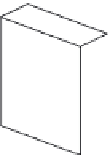Image Processing Reference
In-Depth Information
Image sensor
Intensity noise
Time noise
Space noise
Electronic noise
Device noise
Transistor noise
1/f
Lag
Readout lag
System lag
Frame frequency
Electronic shutter
Spurious resolution
Cross talk of light or
charge
RTN
ermal noise
Dark current
Defect
Space range
Image area size
Time range
Frame number to
be stored
Circuit noise
kTC noise
Wavelength noise
False color
Spe. res. of color filter
Cross talk of light/charge
& CF spe. res. overlap
V
th
variation
Column circuit variance
Remaining noise
Shading
Smear
Transfer ineciency
Wavelength range
Number of filter color
Spe. res. of color filter
Optical noise
Sensitivity variation
(Shading)
Intensity range
Dynamic range
Noise associated
with on-chip ADC
is not treated here
FIGURE 8.3
Image information and elements of quality: image sensor.
spectral response of the color filters in either the visible region or the region outside of the
visible region, depending on the application. Time noise includes lag phenomena caused
at readout from the photodiode and system lag due to the overlap of time information
between successive frames, which is rarely seen these days. Aliasing due to periodical sam-
pling, mentioned in Section 6.3, depends on the relation between frequencies of sampling
and reciprocal motion of the object. Picture blur of an object moving at high speed during
the exposure period, which depends on exposure time, is time noise as well as space noise.
Time range is the number of frames that can be stored and is not commonly an issue, except
for burst-type sensors, in which it is determined by the built-in frame memory volume.
Next, the signal processing part is considered. In the analog front end (AFE), after
correlated noise involved in the analog output signal is reduced through CDS operation,
the signal is amplified with adaptively chosen voltage gain in accordance with signal volt-
age and is translated to a digital signal through an analog-to-digital converter (ADC), as
shown in Figure 8.4. Digital output sensors described in Section 5.3.3.2 complete this step.
Various operations are processed in the digital domain by a DSP. Operated processing is
not restricted to what should be essentially processed for color image signal reproduction,
such as demosaicking (color incorporation), color conversion (color matrix), white balance,
and gamma processing, but is extended to various kinds of correction such as defect
correction, noise cancellation or reduction, chromatic aberration correction and shading
correction, to improve the appearance of the image.
In this way, high revision processing can be realized, which was not possible for ana-
log processing. It could be said that the light makeup of the days of analog signals has
changed to heavy makeup in this digital signal age without attracting attention. Therefore,

















